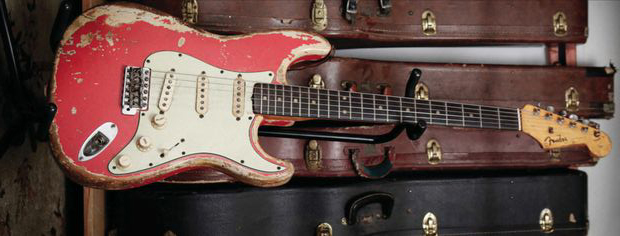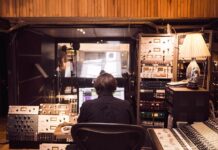Recording guitar
Recording guitar or any other particular instruments requires different rules, no matter if we’re talking about recording in a professional studio or an amateurish workshop. Each instrument demands individual method and good knowledge about elementary techniques of registration, as well as having appropriate recording tools to achieve what you’re aiming for. Today we’re going to discuss the recording of one of the most popular instruments in the world – the electric guitar, metal guitar. It is fascinating not only because of the richness of the sound but also due to its adaptability to every type of music – from metal, trough rock, funk, rap up to every type of electric music.
Beginning recording guitar!
As in registration for every type of music, the most important and pivotal thing is the musician’s talent. It doesn’t matter if we record ourselves, a familiar music band or an unknown artist – the first condition for good recording realization is what the player can create with an electric guitar. It can be boring it’s always true: the results of recording a weak musician with a great instrument will always be worse than the results of a really good player who only has normal, cheap equipment. The key is hidden in a musician’s fingers and it will never change. The technological progress and development of studio recording techniques don’t have any real importance.
Secondly, the instrument has a significant influence on the quality of a record. No-one needs to have it explained to them that a well-made guitar without any problems, which is perfectly shaped and comfortable to play and which has satisfactory electric components gives the highest quality of a sound.
Does this mean that if someone doesn’t have a Gibson, a Fender or a PRS, he should put away his instrument, sell everything and then spend all the money on the best guitar? It’s completely unnecessary! There is an enormous amount of great guitars which are much cheaper, but you have to try some of them first to find the best instrument for you and for the type of music that you are interested in.
The sounds of different models and types of guitars can differ greatly from each other. That’s why good matching to the type of music is as important as the quality of an instrument. Imagine death-metal musicians playing on white Falcons (from Gretsch) – two different worlds; at best it would be hilarious, at worst farcical!
Every guitar player who is working on his own playing style knows that a well-fitted guitar is only one half of his success. It should be paired with a corresponding amplifier and some speakers. The number of possibilities is so big that I won’t even try to mention all of them. It’s the same thing as when pairing a microphone with preamp or passive monitors and with a suitable amplifier; it takes long time to choose a good combination.
The guitar recording conditions.
Now let’s say that we can meet these three conditions – we’ve got a talented musician (or we’re talented musicians), our instrument is more than “quite good” and the sound of the amplifier can annoy the whole neighborhood – we can say that we’re prepared from the musician’s side.
The only thing left to do is turn on our equipment, but first we must check some things:
Make sure that the accommodation is suitable. No-one wants to spoil an elaborate sound because of noises, rumbling, reflection, resonance, standing waves, echoes and other terrible, unpredictable obstacles. Good accommodation is always a very important step to getting professional recordings. Of course, it doesn’t mean anything during the recording itself „trough the Line” (hiZ on the interface), but I’ll talk about it in the next article.
Use good quality cables. I’m not talking about products with crazy and irrational prices for typical users. The offer from Sommer Cables, Monstre Cables, or Klotz should be enough, we shouldn’t just use the cheapest “no-names” with meager plugs which will break down very fast – it’s not worth double investing…
Ask the guitar player to try different picks during rehearsals (I’m not talking about stomps and effects, but about the little plastic triangle held in fingers). I am very serious – the thickness of a pick can have an important influence on the character of the sound and then on the mixing process. The differences between a thick pick and a thin pick are unbelievably large – you should to try to record the same part with both and you’ll see the differences (it will be deeper when recorded on “clear channel”).
Techniques of registration
Sometimes it is impossible to use all the power of our amplifier – especially if you live in a high-rise. Therefore I suggest you displace the studio for the guitar recording time. It’s important because some amplifiers only work best on “11”.
Does this mean that we need a 100-Watt amplifier and a 4×12 pack to get a resplendent sound? No! It is possible to get a massive sound from very small, but nice sounding amplifiers – size isn’t the most important factor.
Let’s assume that we have no restrictions caused by accommodation and we’re now moving on to the next step.
Which microphone will be best?
Very long topic… There are some standard procedures, which can be similar, but we should be prepared for anything. The most common for electric guitar registration with an amplifier is dynamic Shure SM57 – indestructible, durable, and reliable. It is especially excellent for overdriven guitars, but is flexible too. Sennheiser MD 421, 441 or e906 are also often used. Lately, I’ve tried Electrovoice RE-20 and I’ve been pleasantly surprised. I can add that it is used by Thom Yorke from Radiohead – the world of sound really is unpredictable.
Is a dynamic microphone indispensable?
Of course not! There are also a second type of microphones which are returning – Ribbon microphones. Royer Labs R-121, AEA R84 or Coles 4038 are legendary for recording guitar, but even the cheaper versions – R-101, sE or very cheap Fat Cascade II can work well. Remember that they sound dark, murky and gloomy which is why we have to think hard about using them when we’ve got a rough and harsh guitar sound.
What’s about condenser microphones?
They’re not so popular but that doesn’t mean that no-one uses them. The one which deserves particular attention is AKG C414 – it’s not the cheapest one but it works well with big SPL and can imitate the sound of equipment well. I’m very curious about its new cheaper version C214 – I didn’t have an opportunity to try it but I would like to do so.
If we’re talking about recording guitar without any distortion, overdrive or fuzz, here are some tools which can be really brilliant. Their ability to catch details can give us exactly what we need or even more!
Where should a microphone be?
Of course, it depends on the sound which we are interested in! When we set the microphone, we should look at three things:
Distance from the amplifier
Distance from the center of a speaker
Angle of the microphone
1. The closer to the amplifier we set the microphone, the more bass sound we’ll get. This is perfect for „proximity effect” which we can see in this situation. The distance helps in setting a balance for the amount of bass in a recording.
2. The closer to the center of a speaker we set the microphone, the lighter and clearer the sound will be. The setup directly on the center may cause the sound to be exaggerated and devoid of perfect balance and weight – which is tiring after a while. The further from the center of speaker we set the microphone, the heavier the sound, and it also loses its extremeness. At the edges of the speaker the sound will become more matt.
3. Setting the microphone at a certain angle also changes the character of the sound because the microphone reacts in different ways. If a response on the sound is an “off-axis response” and it’s quite good, then we can change the angle ex. to the center of amplifier – the sound will be clearer, brighter and also without an excessive contour and with perfect weight.
Finding the best position for a microphone is quite time consuming and it requires some trials – it is a bit like later correction in a mix. It is still much easier to find a satisfactory balance by carefully manually setting the microphone, rather than trying to fix it later on, in an EQ setup.
Stereo recording
If you work on a good sound and microphone setup, the second microphone and stereo recording won’t be necessary. It would be better to record something twice with some changes, than use two microphones from the beginning. If you don’t get satisfactory results with one microphone, the second will probably harm the recording guitar even more.
No-one will stop you from trying, but it’s important to remember about phases – forgetting this issue can cause unpredictable problems.
If you really want to register on two microphones, you should set them up separately – for example, put one near the amplifier and the second further away (if the accommodation is suitable). The signals will be different and they will allow you to create interesting effects by balance manipulation.


![TOP 10 Best Synth VST plugins [The Ultimate Buyer’s Guide] in 2023 Top 10 best vst Instruments for music production](https://www.lucidsamples.com/blog/wp-content/uploads/2019/07/Best_Vst_Instruments-218x150.png)




